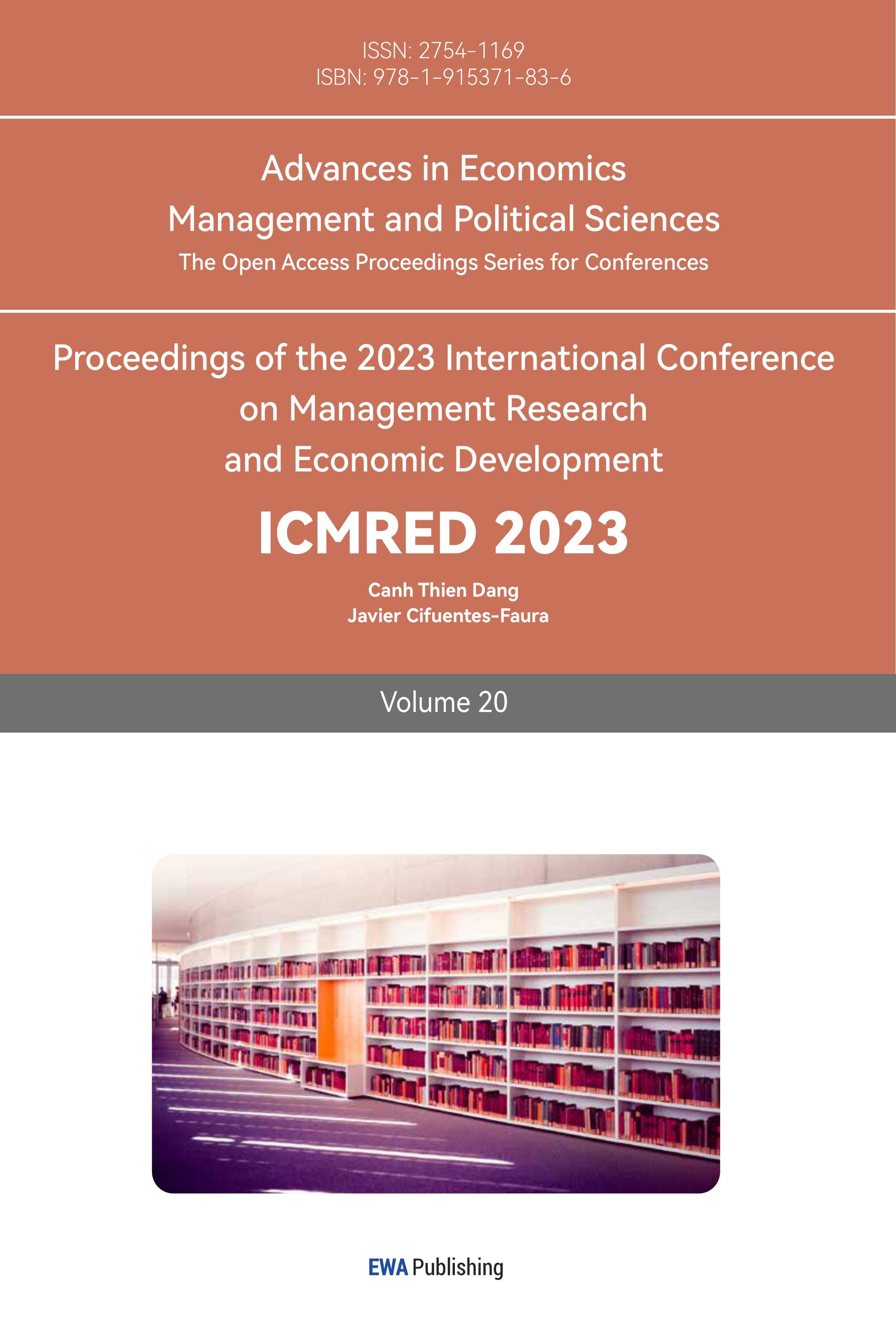1. Introduction
The advent of COVID-19 in 2019 has wreaked havoc on the existing social and economic environment in the context of the global backdrop. According to the data, the worldwide economic downturn that was brought on by COVID-19 has brought the rate of unemployment all across the world up to within a striking distance of 2% [1]. The growth in the unemployment rate will have a detrimental effect on the income of a segment of the world's population. The drop in income will have an immediate and direct impact on the shifting behaviors of consumers. When people have less money available for discretionary spending, they will have fewer options available to them [2]. During the COVID-19 period, many countries have decided to conduct lockdowns in an effort to minimize the incidence of disease transmission. As a result, the majority of people are required to remain inside their homes for an extended amount of time. As a result, shopping online has gradually supplanted traditional shopping methods [3].
According to research and statistics from McKinsey, the impact of COVID-19 on the economic climate has radically impacted consumer behavior. Specifically, customers are more prone than in the past to relinquish their commitment to a particular brand or product. During the COVID-19 period, delayed transportation and unpredictable supply chains frequently result in a certain product being out of stock or even withdrawn, compelling customers to select equivalent alternatives instead. While customers are under the effect of lock-down and social distance policies, it is difficult for them to accept past "normal" outing activities. On the other hand, when consumers are shopping, they are more likely to buy healthier products. Along with whether or not the firm uses packaging that is beneficial to the environment, one of the most essential aspects to consider when deciding whether or not to buy items from a particular company is whether or not the company takes care of its personnel during an outbreak [4].
A large number of researchers have investigated changes in consumer behavior throughout the COVID-19 era Fig.1, yielding a huge variety of research outcomes. This article will initiate by conducting the literature review in order to analyze the research methods and findings of other relevant scholars on the impact of COVID-19 on the change in consumer behavior. This essay will next perform a critical study of these conclusions in order to understand their limitations and obtain insight into COVID-19's future.
2. Methodology
Through the analysis of a large body of pertinent literature, it has been determined that when scholars investigate the impact of COVID-19 on the alteration of consumer behaviour, they primarily use two research methods: surveys and secondary data. To illustrate how iraqi consumers gradually shifted their shopping habits to online shopping during the epidemic, scholars investigated the sales share from 2019 to 2020 using secondary data provided by Samsung’s distributor in iraq [5]. At the same time, when another scholar was researching the impact of COVID-19 on retail consumer behaviour change, he also utilised e-commerce data in order to obtain more convincing evidence that, during the epidemic, consumers are more willing to purchase everyday products online [6]. According to McKinsey's global perspective on the impact of COVID-19 on consumer behaviour, the key technique by which they collect data is by conducting surveys with customers from 45 different countries, and the survey approach involves a number of directions: Changes in consumers' earnings; consumer forecasts regarding the recovery time of the pandemic; consumers' thought process before purchasing items; consumers' attitude when purchasing products; changes in the types of products customers purchase following the outbreak; and determine the most influential customer purchasing factors. The objective of these interview questions is to collect a big quantity of authentic and useful experimental data. McKinsey conducted additional quantitative analysis on the collected data and drew a summary of the findings that incorporated a global perspective [4]. In addition, a different article that investigates the Learning of the Effects of the COVID-19 Pandemic on Consumer Behavior also uses a survey to determine what factors cause changes in consumer behavior, why consumers prefer online shopping, and whether there are real differences in the amount of product consumed by consumers of different ages during an epidemic. Similarly to McKinsey, they obtained their outcomes through the application of quantitative analysis [7].
3. Changing in Consumer Purchasing Behavior under COVID-19
3.1. Result 1: Consumer Moved the Purchasing Focus to Daily Necessity
The analysis of a considerable amount of scientific literature led to the conclusion that during the COVID-19 epidemic, consumers imposed stronger consumption constraints on daily necessities than they had in the years preceding the emergence of the disease. There are probably two significant contributing factors to this phenomenon. First of all, as a result of the uncertain economic climate generated by the epidemic, a large number of people will lose their means of survival as a result of the decision of many firms to lay off some of their personnel. During the same period, some firms are unable to operate normally due to the outbreak Fig.2. In order to achieve cost savings, the company's flagship operation will reduce staff compensation [8]. Consumers will opt to purchase only the necessities, such as food, water, and toilet paper, in order to conserve money and prevent unnecessary expenditures while remaining within their financial means [3]. Or, to some degree, certain individuals are able to cover the costs of these necessities only during the epidemic stage through their income.
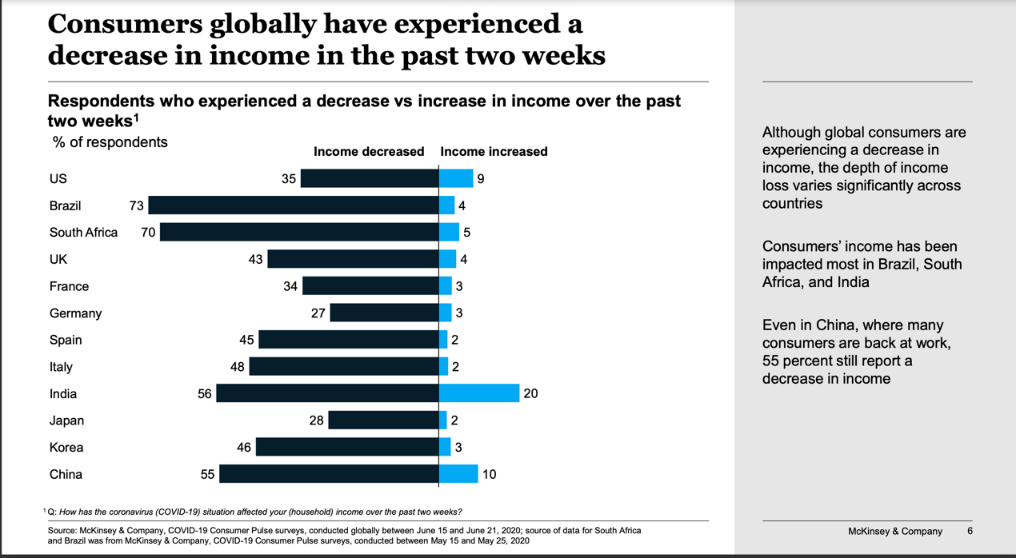
Figure 1: Consumers globally have experienced a decrease in income in the past two weeks [4].
This graph demonstrates that there is a decrease in income in the past few weeks globally.
Secondly, for those consumers whose income has not changed, the majority of consumption is also truly limited to life's necessities. Due to the severity of the epidemic, it is difficult for many clients, especially those from China, to anticipate the end of the epidemic. The broad negative perceptions that customers have of the pandemic will improve the public's awareness of the dangers associated with consumption risks. They will question whether spending money on non-essential products will have a negative impact on their lives in the future. For instance, if people purchase expensive stuff presently, such as vehicles, and the pandemic continues to spread, it is probable that their source of income would be greatly disrupted, as purchasing automobiles requires a considerable amount of money and they have just purchased expensive items. Purchasing autos will inevitably result in a reduction in the level of living enjoyed by all family members over time [9]. Therefore, in order to retain their existing living levels into the foreseeable future, these consumers will exercise greater restraint in their use of non-essential products and services.
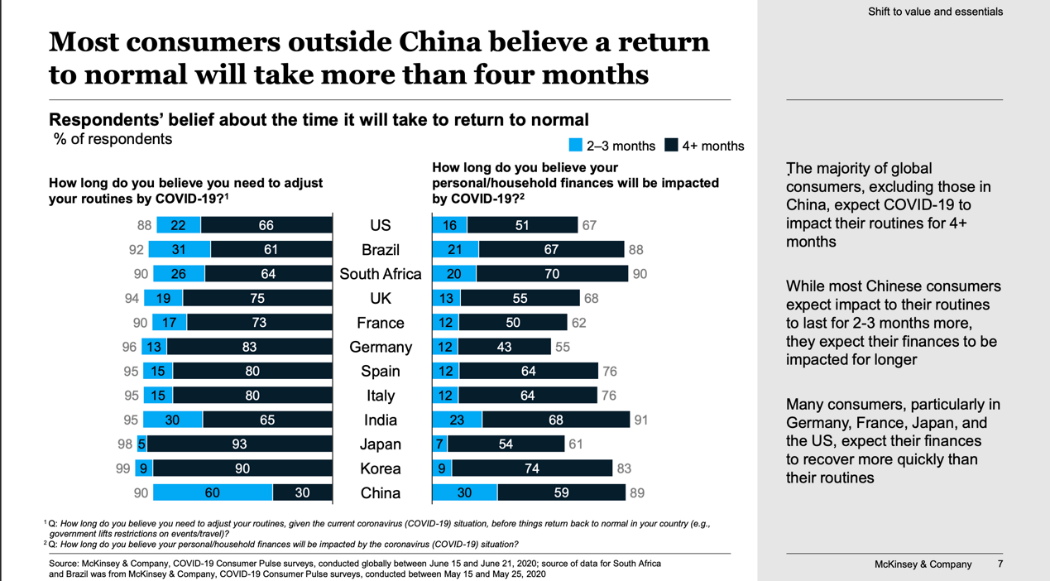
Figure 2: Most consumers outside China believe a return to normal will take more than four months [4].
This graph demonstrates the expectations of current consumers in returning to normal life.
3.2. Result 2: The Number of Online Shopping Increased Under COVID-19
The next conclusion that can be derived from the review of the relevant research is that customers use internet shopping more frequently during the COVID-19 pandemic than they did prior to the outbreak. According to the survey conducted by McKinsey, the transaction rate for online purchases increased by 17% during the epidemic period compared to the rate seen before the outbreak [10]. Numerous governments and regions have incorporated social distancing and lockdown into their policies for the prevention and control of epidemics. This is done to minimise the number of people that assemble in large groups, which can contribute to a more broad possibility of an epidemic breakout. During the Lockdown, everyone is compelled to remain inside their homes, unless they have jobs that need them to be outside. No one is permitted to leave their homes to engage in any social activity. Therefore, at that time, the only way to get commodities from the outside world was through internet shopping. In addition, a lot of studies have demonstrated that when social distance and lockdown rules are implemented, customers will suffer an increase in feelings of loneliness since they would have fewer opportunities to interact with individuals from the outside world. This sense of loneliness will also encourage clients to utilise online networking services more frequently; Online shopping is one of the ways to increase customer's interaction with the outside community [11].
Secondly, during the epidemic, the unstable transportation environment caused a considerable number of products to be out of stock for an extended period of time. Many clients may discover that they are unable to buy all of the items on their wish lists at one shop. To find a package of tissue, they may have to traverse the entire city, stop at numerous stores, or even make repeated trips [12]. However, people can avoid this problem by buying online, as many online supermarkets display the quantity of stock available for each item on the product page, and online supermarkets only require a small amount of money to help consumers get their commodities home. This service is especially beneficial for the elderly and disabled people who are forced to live alone as a result of the epidemic.
Prior to the epidemic, a large majority of consumers lacked the time and incentive to educate themselves on how to use online shopping platforms. However, due to COVID-19, they can only purchase items from the outside world via internet shopping Fig.3. Through this process, consumers will also discover that when they shop online, they have access to more beneficial product information. For example, When customer acquire a bottle of water glass, they can browse the product's specific information , how to use it and the buyer's use experience, and they can compare prices on multiple websites to obtain more cost-effective pricing. [13] This process ensures that every item that they purchased represents good value for money Fig. 4.
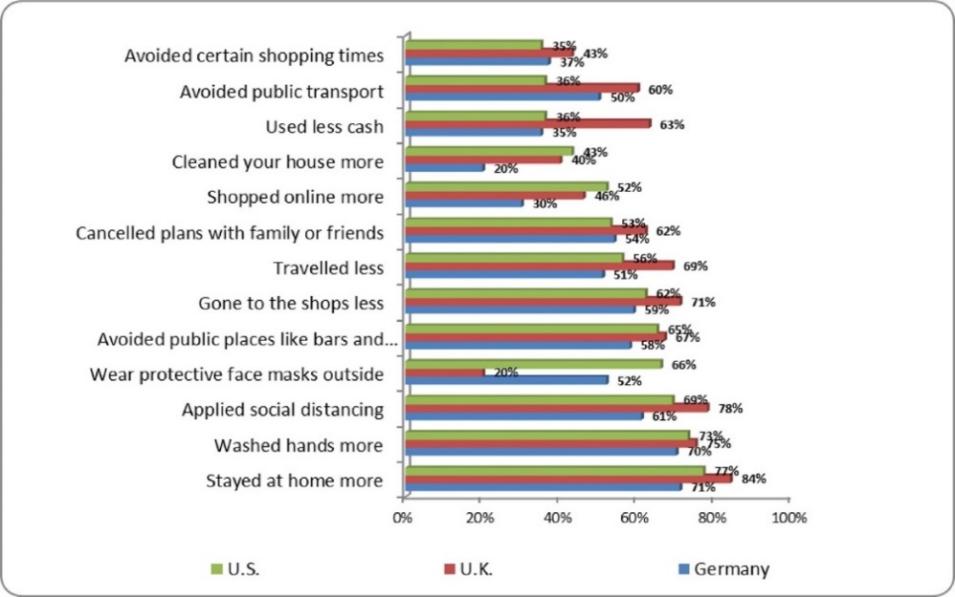
Figure 3: Lifestyle changes during COVID-19 pandemic (multiple choice answers) [14].
This graph indicates the changing way of living under COVID-19 in U.S., U.K. and Germany.
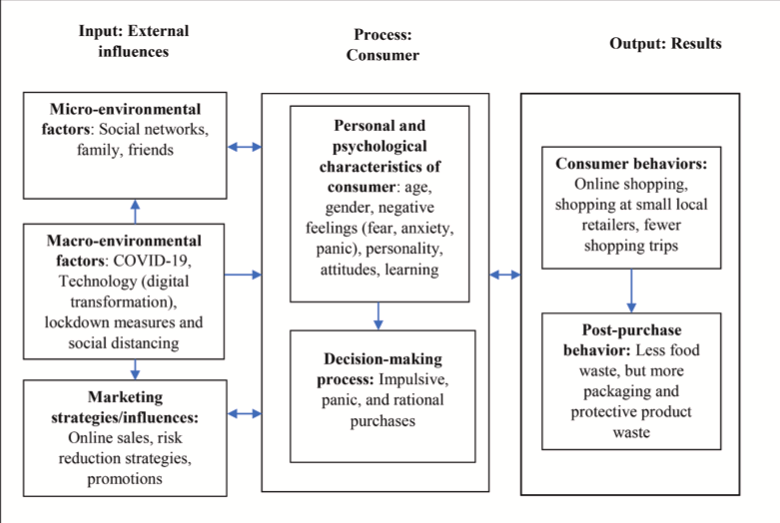
Figure 4: Model of consumer behavior during the COVID-19 crisis [15].
This graph indicates the factors that affect consumer purchasing.
4. Limitations and Future Outlooks
Reading and analysing a massive number of related scientific literature has revealed that the papers on this topic are missing around three crucial components. To begin with, only a few of the published articles on the issue of the influence of COVID-19 on consumer behaviour have focused their research focus to a specific age group. However, it has been noted that people of different age groups behave differently as a direct result of the epidemic. For instance, some elderly people may fear the epidemic more than younger people since their source of income and physical health are not as excellent as those of young people today. Therefore, their consumption habits will differ from those of young adults. However, there are almost no articles that give evidence for this similar correlation hypothesis at this time. Secondly, many existing papers on this topic are focused on the consumption of products designed for everyday use, and no one has conducted extensive studies on product categories such as luxury goods. Last but not least, the pandemic persisted for a number of years in numerous nations, and relatively few of the studies on this topic concentrated on a specific phase of the epidemic.
If it is possible, there should be more scholars conducting in-depth research in this field. For example, there should be a greater emphasis on study into how consumers of various ages act. In addition, luxury consumption is a significant component of daily consumption for some clients, so this related product should be included in the scope of the study to account for this phenomenon. Due to the length of time the epidemic lasted, specialised study can be divided into three distinct time phases: before the epidemic, during the epidemic, and post-the epidemic. The research can even be further subdivided into each different period Changes in consumer behaviour in various regions.
5. Conclusion
The conclusion of this paper, which explores the impact of COVID-19 on changes in consumer behaviour, is supported by the literature review. The conclusion that can be derived from this paper is that throughout the period of the pandemic, due to the reduction in income of some groups and the increase in the crisis consciousness of purchasing products, the proportion of consumers who only consumed daily essentials increased significantly. In addition, as a result of the development of online shopping platforms during the pandemic, it is pretty convenient and efficient, and buyers are more adept and accustomed to making purchases via online shopping platforms. This essay, which highlights the changes in consumer behaviour as a result of the pandemic, as well as the limitations and future prospects based on this conclusion, can provide future scholars who wish to investigate this topic with a clear background and a more specific research direction.
References
[1]. Fernandes, N. (2020). Economic effects of coronavirus outbreak (covid-19) on the World Economy. SSRN Electronic Journal. https://doi.org/10.2139/ssrn.3557504
[2]. Ahmed, M. E., Khan, M. M., & Samad, N. (2016). Income, Social Class And Consumer Behaviour: A Focus On Developing Nations. Institute of Business Management, 14(10). https://doi.org/https://ssrn.com/abstract=3648141
[3]. Sheth, J. (2020). Impact of covid-19 on consumer behavior: Will the old habits return or die? Journal of Business Research, 117, 280–283. https://doi.org/10.1016/j.jbusres.2020.05.059
[4]. Arora, N., Charm, T., Grimmelt, A., Ortega, M., Robinson, K., Sexauer, C., Staack, Y., Whitehead, S., & Yamakawa, N. (2020). A global view of how consumer behavior is changing amid COVID-19. Mckinsey and Company. Retrieved from https://www.amchamegyptinc.org/bic/pdf/corona1/a-global-view-of-how-consumer-behavior-is-changing-mid-COVID-19.pdf
[5]. Ali, B. J. (2020). Impact Of Covid-19 On Consumer Buying Behavior Toward Online Shopping In Iraq. Economic Studies Journal, 18(3), 267–280. https://ssrn.com/abstract=3729323
[6]. Sayyida, S., Hartini, S., Gunawan, S., & Husin, S. N. (2021). The impact of the COVID-19 pandemic on Retail Consumer Behavior. Aptisi Transactions on Management (ATM), 5(1), 79–88. https://doi.org/10.33050/atm.v5i1.1497
[7]. Hesham, F., Riadh, H., & Sihem, N. K. (2021). What have we learned about the effects of the COVID-19 pandemic on consumer behavior? Sustainability, 13(8), 4304. https://doi.org/10.3390/su13084304
[8]. Crespí-Cladera, R., Martín-Oliver, A., & Pascual-Fuster, B. (2021). Financial distress in the hospitality industry during the COVID-19 disaster. Tourism Management, 85, 104301. https://doi.org/10.1016/j.tourman.2021.104301
[9]. Mehta, S., Saxena, T., & Purohit, N. (2020). The new consumer behaviour paradigm amid covid-19: Permanent or transient? Journal of Health Management, 22(2), 291–301. https://doi.org/10.1177/0972063420940834
[10]. Fabius, V., Kohli, S., Timelin, B., & Veranen, S. M. (2020, October 21). How covid-19 is changing consumer behavior--now and forever. McKinsey & Company. Retrieved from https://www.mckinsey.com/industries/retail/our-insights/how-covid-19-is-changing-consumer-behavior-now-and-forever
[11]. Donthu, N., & Gustafsson, A. (2020). Effects of COVID-19 on business and research. Journal of Business Research, 117, 284–289. https://doi.org/10.1016/j.jbusres.2020.06.008
[12]. Adibfar, A., Gulhare, S., Srinivasan, S., & Costin, A. (2022). Analysis and modeling of changes in online shopping behavior due to covid-19 pandemic: A florida case study. Transport Policy, 126, 162–176. https://doi.org/10.1016/j.tranpol.2022.07.003
[13]. Wang, C., & Katawetawaraks, C. (2011). Online Shopper Behavior: Influences of Online Shopping Decision. Asian Journal of Business Research, 1(2). https://doi.org/http://ssrn.com/abstract=2345198
[14]. Oana, D. (2020). The impact of the current crisis generated by the COVID-19 pandemic on consumer behavior. Studies in Business and Economics, 15(2), 85–99. https://doi.org/10.2478/sbe-2020-0027
[15]. Cruz-Cárdenas, J., Zabelina, E., Guadalupe-Lanas, J., Palacio-Fierro, A., & Ramos-Galarza, C. (2021). Covid-19, Consumer Behavior, technology, and Society: A Literature Review and Bibliometric analysis. Technological Forecasting and Social Change, 173, 121179. https://doi.org/10.1016/j.techfore.2021.121179
Cite this article
Cui,Y. (2023). The Change of Consumer Behavior within the Context of COVID-19. Advances in Economics, Management and Political Sciences,20,237-242.
Data availability
The datasets used and/or analyzed during the current study will be available from the authors upon reasonable request.
Disclaimer/Publisher's Note
The statements, opinions and data contained in all publications are solely those of the individual author(s) and contributor(s) and not of EWA Publishing and/or the editor(s). EWA Publishing and/or the editor(s) disclaim responsibility for any injury to people or property resulting from any ideas, methods, instructions or products referred to in the content.
About volume
Volume title: Proceedings of the 2023 International Conference on Management Research and Economic Development
© 2024 by the author(s). Licensee EWA Publishing, Oxford, UK. This article is an open access article distributed under the terms and
conditions of the Creative Commons Attribution (CC BY) license. Authors who
publish this series agree to the following terms:
1. Authors retain copyright and grant the series right of first publication with the work simultaneously licensed under a Creative Commons
Attribution License that allows others to share the work with an acknowledgment of the work's authorship and initial publication in this
series.
2. Authors are able to enter into separate, additional contractual arrangements for the non-exclusive distribution of the series's published
version of the work (e.g., post it to an institutional repository or publish it in a book), with an acknowledgment of its initial
publication in this series.
3. Authors are permitted and encouraged to post their work online (e.g., in institutional repositories or on their website) prior to and
during the submission process, as it can lead to productive exchanges, as well as earlier and greater citation of published work (See
Open access policy for details).
References
[1]. Fernandes, N. (2020). Economic effects of coronavirus outbreak (covid-19) on the World Economy. SSRN Electronic Journal. https://doi.org/10.2139/ssrn.3557504
[2]. Ahmed, M. E., Khan, M. M., & Samad, N. (2016). Income, Social Class And Consumer Behaviour: A Focus On Developing Nations. Institute of Business Management, 14(10). https://doi.org/https://ssrn.com/abstract=3648141
[3]. Sheth, J. (2020). Impact of covid-19 on consumer behavior: Will the old habits return or die? Journal of Business Research, 117, 280–283. https://doi.org/10.1016/j.jbusres.2020.05.059
[4]. Arora, N., Charm, T., Grimmelt, A., Ortega, M., Robinson, K., Sexauer, C., Staack, Y., Whitehead, S., & Yamakawa, N. (2020). A global view of how consumer behavior is changing amid COVID-19. Mckinsey and Company. Retrieved from https://www.amchamegyptinc.org/bic/pdf/corona1/a-global-view-of-how-consumer-behavior-is-changing-mid-COVID-19.pdf
[5]. Ali, B. J. (2020). Impact Of Covid-19 On Consumer Buying Behavior Toward Online Shopping In Iraq. Economic Studies Journal, 18(3), 267–280. https://ssrn.com/abstract=3729323
[6]. Sayyida, S., Hartini, S., Gunawan, S., & Husin, S. N. (2021). The impact of the COVID-19 pandemic on Retail Consumer Behavior. Aptisi Transactions on Management (ATM), 5(1), 79–88. https://doi.org/10.33050/atm.v5i1.1497
[7]. Hesham, F., Riadh, H., & Sihem, N. K. (2021). What have we learned about the effects of the COVID-19 pandemic on consumer behavior? Sustainability, 13(8), 4304. https://doi.org/10.3390/su13084304
[8]. Crespí-Cladera, R., Martín-Oliver, A., & Pascual-Fuster, B. (2021). Financial distress in the hospitality industry during the COVID-19 disaster. Tourism Management, 85, 104301. https://doi.org/10.1016/j.tourman.2021.104301
[9]. Mehta, S., Saxena, T., & Purohit, N. (2020). The new consumer behaviour paradigm amid covid-19: Permanent or transient? Journal of Health Management, 22(2), 291–301. https://doi.org/10.1177/0972063420940834
[10]. Fabius, V., Kohli, S., Timelin, B., & Veranen, S. M. (2020, October 21). How covid-19 is changing consumer behavior--now and forever. McKinsey & Company. Retrieved from https://www.mckinsey.com/industries/retail/our-insights/how-covid-19-is-changing-consumer-behavior-now-and-forever
[11]. Donthu, N., & Gustafsson, A. (2020). Effects of COVID-19 on business and research. Journal of Business Research, 117, 284–289. https://doi.org/10.1016/j.jbusres.2020.06.008
[12]. Adibfar, A., Gulhare, S., Srinivasan, S., & Costin, A. (2022). Analysis and modeling of changes in online shopping behavior due to covid-19 pandemic: A florida case study. Transport Policy, 126, 162–176. https://doi.org/10.1016/j.tranpol.2022.07.003
[13]. Wang, C., & Katawetawaraks, C. (2011). Online Shopper Behavior: Influences of Online Shopping Decision. Asian Journal of Business Research, 1(2). https://doi.org/http://ssrn.com/abstract=2345198
[14]. Oana, D. (2020). The impact of the current crisis generated by the COVID-19 pandemic on consumer behavior. Studies in Business and Economics, 15(2), 85–99. https://doi.org/10.2478/sbe-2020-0027
[15]. Cruz-Cárdenas, J., Zabelina, E., Guadalupe-Lanas, J., Palacio-Fierro, A., & Ramos-Galarza, C. (2021). Covid-19, Consumer Behavior, technology, and Society: A Literature Review and Bibliometric analysis. Technological Forecasting and Social Change, 173, 121179. https://doi.org/10.1016/j.techfore.2021.121179





